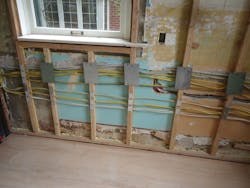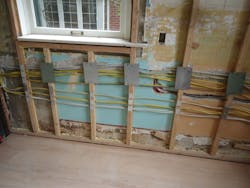Remodeling Tip for Old Masonry Homes: Always Fur the Inside Walls
Furring the inside of masonry walls makes room for wires and can significantly improve the R-value
Before World War II, houses in Denver were solid masonry. This regulation was in place because 5 years after Denver's founding all of the wood buildings that made up the city burned down. Frame homes were finally allowed after the war to cope with the housing boom caused by returning servicemen and their families.
Consequently, all of our work on pre WW2 homes involves structural masonry homes: Queen Anne Victorians, stately Foursquares, solid brick bungalows, and Tudor cottages. Masonry is a terrific product; it is solid and massive, creating a thermal lag effect that has the cool of the evening permeating the brick to mitigate the heat of a summer day. But what it is NOT good at is insulation.
Brick has an R value of about .11 per inch, so a typical 9” masonry wall (2 wythes w/ plaster plus an airspace) has an effective R value of R-1.8 at best. Not very impressive, given that code minimum here is R19!
Brick and block are also difficult to snake wire through.
We have made it our policy to fir the inside of all masonry walls in rooms we work on, especially bathrooms and kitchens. Although we cannot possibly achieve the code mandated R-19 for new homes in a 1 1/2 inch space, we figure that R-7.5, as was done here, is a tremendous improvement over the original uninsulated wall.
The second reason for firring the walls is equally important: it gives the electricians room to run new cables and to set work boxes. Current codes require separate circuits for all appliances, and frequent outlets. This 1-½ inch furred space is just the ticket to get that done.
Otherwise, they’d have to chisel pathways through the masonry.
Here's how my contractor describes doing it:
- First we use a laser to get a 2x2 top and bottom plate set plumb to each other.
- Then we cut the vertical 2x2 ‘s and use string between top and bottom to gauge plumb. Most old masonry walls are far from plumb, so if you just fasten the furring to them, you just recreate the out of plumb condition you are starting with.
- We use construction adhesive and masonry nails to fasten the furring strips.
- To bulletproof the installation, we go back and predrill for ¼” Tapcon fasteners”
(From Fred Ahlert, of CCM, Inc)
For more on the diminishing importance of additional R-value, read Allison Bailes (the Energy Vanguard)’s blog The Diminishing Returns of More Insulation.
— Doug Walter, AIA, is an architect in Denver, Colorado who specializes in remodeling.

